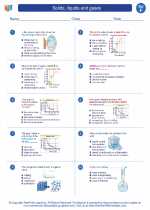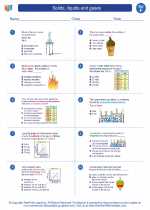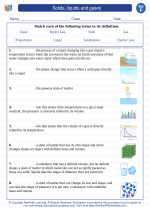Solids, liquids and gases -> natural phenomena
Natural Phenomena
Natural phenomena are observable events that occur in the natural environment and are not man-made. These phenomena are a result of various natural processes and can be studied and understood through scientific investigation.
Types of Natural Phenomena
There are many types of natural phenomena, including:
- Weather phenomena: Such as thunderstorms, tornadoes, hurricanes, and snowstorms.
- Geological phenomena: Including earthquakes, volcanic eruptions, and landslides.
- Astronomical phenomena: Such as eclipses, meteor showers, and the movement of celestial bodies.
- Biological phenomena: Including the life cycles of plants and animals, migration patterns, and natural selection.
- Physical phenomena: Such as the formation of rainbows, the behavior of waves, and the process of erosion.
Studying Natural Phenomena
To study natural phenomena, scientists use various methods and tools, including observation, experimentation, and data analysis. Here are some key steps to consider when studying natural phenomena:
- Observation: Carefully observe the natural phenomenon in its natural environment, noting its characteristics and behavior.
- Hypothesis formation: Develop a hypothesis or educated guess about the cause or underlying mechanism of the phenomenon based on observations and existing knowledge.
- Experimentation: Design and conduct experiments to test the hypothesis and gather data that can be used to support or refute it.
- Data analysis: Analyze the data collected during the experiments to draw conclusions about the natural phenomenon and its properties.
- Communication: Share the findings with the scientific community through publications, presentations, and discussions to contribute to the collective understanding of natural phenomena.
Study Guide
Here are some key concepts and questions to consider when studying natural phenomena:
Key Concepts:
- The different types of natural phenomena
- The methods and tools used to study natural phenomena
- The impact of natural phenomena on the environment and human society
- The role of natural phenomena in shaping the Earth's landscapes and ecosystems
Study Questions:
- What are the main types of natural phenomena and how do they differ from man-made phenomena?
- How do scientists study natural phenomena and what are the key steps in the scientific method?
- What are some examples of natural phenomena that have had a significant impact on human society?
- How do natural phenomena contribute to the formation and transformation of Earth's geological features?
◂Science Worksheets and Study Guides Sixth Grade. Solids, liquids and gases
Study Guide Solids, liquids and gases
Solids, liquids and gases  Activity Lesson
Activity Lesson Solids, Liquids & Gases
Solids, Liquids & Gases  Worksheet/Answer key
Worksheet/Answer key Solids, liquids and gases
Solids, liquids and gases  Worksheet/Answer key
Worksheet/Answer key Solids, liquids and gases
Solids, liquids and gases  Worksheet/Answer key
Worksheet/Answer key Solids, liquids and gases
Solids, liquids and gases  Vocabulary/Answer key
Vocabulary/Answer key Solids, liquids and gases
Solids, liquids and gases  Vocabulary/Answer key
Vocabulary/Answer key Solids, liquids and gases
Solids, liquids and gases 

 Activity Lesson
Activity Lesson
 Worksheet/Answer key
Worksheet/Answer key
 Worksheet/Answer key
Worksheet/Answer key
 Worksheet/Answer key
Worksheet/Answer key
 Vocabulary/Answer key
Vocabulary/Answer key
 Vocabulary/Answer key
Vocabulary/Answer key

The resources above cover the following skills:
PHYSICAL SCIENCE
Energy
Students who demonstrate understanding can:
Plan an investigation to determine the relationships among the energy transferred, the type of matter, the mass, and the change in the average kinetic energy of the particles as measured by the temperature of the sample.